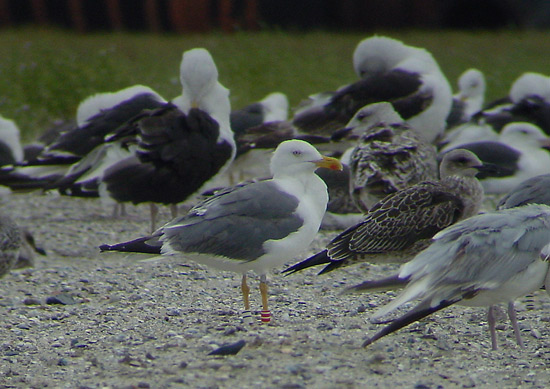
LBBG hybrid =3, August 22 2003, IJmuiden, the Netherlands (52.27N-04.33E) .
LBBG male 6cy, ringed as pullus at IJmuiden, summer 1998, ringed double bar, triple bar. Seen again in 2001 and territorial in 2002 in the local LBBG population at IJmuiden. It's a pale grey individual, paler than LBBG, but darker than YLG, with strong, powerful jizz. Head more like YLG: orange-red orbital ring, largely orange-yellow bill with strong gonydeal angle. Pattern on upper-wing more in line with YLG, lacking black on P4 and the sub-terminal band on P5 just reaching the inner-web. All primaries still present at May 26 2003, and primary moult stage averages the local true LBBG in late August: P7-P10 still old, P6 shed. For comparison, data on moult stages of adult michahellis from NW France are included:
| Remaining old primaries in adult michahellis, Etaples, NW France. | ||||||||
| 0 old | P10 old | P10-P9 | P10-P8 | P10-P7 | n: | m: | SD: | |
| August 22 2000 | 6 | 20 | 43 | 3 | 0 | 72 | 1,60 | 0.71 |
| August 25 2000 | 5 | 17 | 38 | 1 | 0 | 61 | 1,57 | 0.67 |
This LBBG hybrid =3 is a straight offspring from the female ancestor =9, which was ringed May 23 1994. Fred Cottaar, ringer at the LBBG complex in IJmuiden published an article about Yellow-legged Gulls and hybrids breeding at IJmuiden in Dutch Birding 26: pp 36-42, 2004. The summary:
Since 1987, small numbers of Yellow-legged Gulls (Larus michahellis) have been breeding in mixed colonies of European Herring Gull (L. argentatus argenteus) and Lesser Black-backed Gull (L. fuscus graellsii) at Ijmuiden, Noord-Holland, the Netherlands. Almost all were paired with LBBG, producing hybrid young. By trapping and colour-ringing birds, it was possible to follow them over the years. Some of the adults hybrids returned to the colonies and started to breed, always paired with LBBG. In 2002 the number of breeding Yellow-legged Gulls and hybrids was at least seven. On May 12 1997, a female that had been breeding and producing hybrids since 1991was trapped and a blood sample was taken for DNA-analysis. This indicated that she was not a pure Yellow-legged Gull, although she looked like one, but that one of her female ancestors had been a European Herring Gull. With this in mind, and with a growing number of known hybrids and possible back-crosses in the colonies, it has become increasingly difficult to be sure of identification when seeing a yellow-legged gull.
A page dealing with hybrids Yellow-legged Gull x Lesser Black-backed Gull was published by Peter Adriaens at SURFBIRDS.COM.
